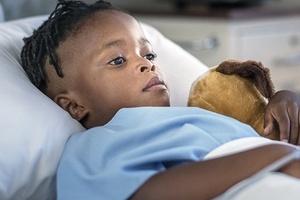SHINE trial on shorter treatment for children with minimal TB
TB treatment can be shortened from six to four months in 80% of children.
26 October 2020, Geneva | The World Health Organization’s (WHO) Global TB Programme welcomes the results from an important study on shortened treatment for drug-susceptible tuberculosis (TB) in children, presented at the 51st virtual Union World Conference on Lung Health. The study, named SHINE (Shorter Treatment for Minimal Tuberculosis in Children), was sponsored by University College London (UCL), coordinated by the Medical Research Council Clinical Trials Unit at UCL, and funded by the Joint Global Health Trials Scheme of the Department for International Development, the UK Department of Health and Social Care, the Wellcome Trust, and the Medical Research Council, with additional support from the TB Alliance.
The SHINE trial is a phase 3 randomised open-label trial
comparing four versus six months of treatment with rifampicin,
isoniazid, pyrazinamide plus or minus ethambutol in children
with smear-negative, non-severe TB. It was conducted in five
study sites in South Africa, Uganda, Zambia and India. 1204
children aged under 16 years participated in the trial,
including 127 children living with HIV infection. Minimal TB was
defined as TB which is both sputum smear negative and
non-severe, including extra-thoracic lymph node TB and
non-severe respiratory TB (as determined on chest x-ray).
The
children were randomised to receive either six months or four
months of treatment, with the continuation phase of treatment
shortened from four to two months in the four-month arm. They
were then followed up for 18 months.
The key finding
was that four months of treatment was non-inferior to the
standard six-month treatment. There was no statistically
significant difference when comparing the six months and four
months groups in terms of the proportion with an unfavourable
outcome (treatment failure, TB recurrence, death of any cause,
and loss-to-follow-up). Side-effects related to treatment were
few, and similar across both groups.
Every
year, it is estimated that 1.2 million children develop TB and
230,000 die, most of them without having accessed care and
treatment. The majority of children with TB have less severe
forms of the disease. Long treatment regimens can result in high
costs to families and health services, potentially with added
toxicity, risks of drug-drug interactions in children living
with HIV, and problems with pill-burden and adherence. Shorter
and effective, yet safe treatment regimens for children with
both drug-susceptible and drug-resistant TB are a key
intervention to achieve the WHO’s End TB Strategy targets,
as well as the targets related to children set during the United
National General Assembly High Level Meeting on TB in 2018. The
findings from this study have the potential to update current
guidelines for the treatment of drug-susceptible TB in
children.
WHO public health recommendations are based
on robust and representative scientific data, and are developed
using an evidence-based, systematic approach. In order to ensure
that patients are offered the most effective and safest
treatment regimens, WHO regularly reviews the findings from key
studies on TB treatment. The results from the SHINE trial are
important in this regard and, once final data become available,
will be considered during WHO’s ongoing processes to
refine current policy recommendations on the treatment of
drug-susceptible TB in children.
Source:
WHO


